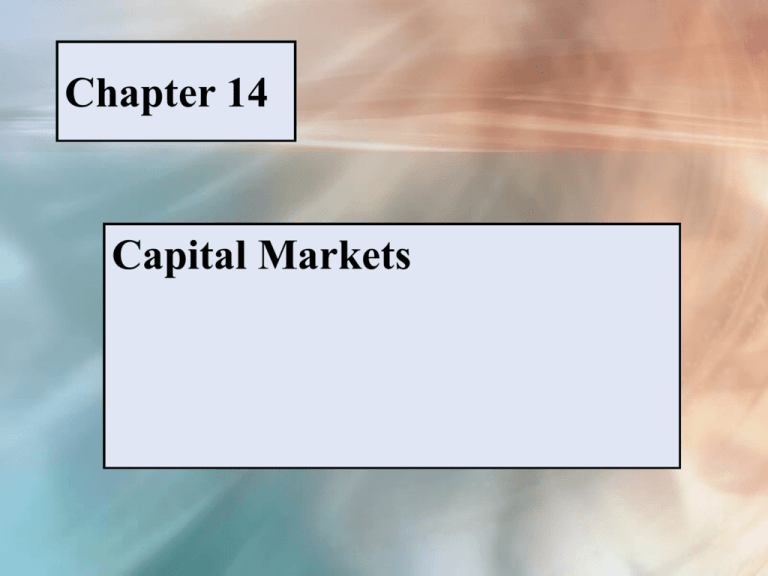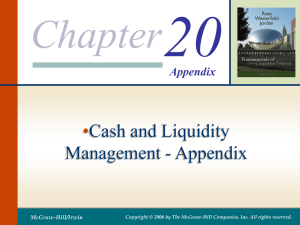
Chapter 14
Capital Markets
FIGURE 14-1
Internally generated funds:
Depreciation and retained earnings
McGraw-Hill/Irwin
PPT 14-1
© 2005 The McGraw-Hill Companies, Inc., All Rights Reserved.
PPT 14-2
FIGURE 14-2
Flow of funds
through the
economy
McGraw-Hill/Irwin
© 2005 The McGraw-Hill Companies, Inc., All Rights Reserved.
PPT 14-3
FIGURE 14-3
Suppliers of funds to
credit markets
McGraw-Hill/Irwin
© 2005 The McGraw-Hill Companies, Inc., All Rights Reserved.
PPT 14-4
TABLE 14-3
Global stock markets
McGraw-Hill/Irwin
© 2005 The McGraw-Hill Companies, Inc., All Rights Reserved.
Chapter 14 - Outline
LT 14-1
Capital
Markets vs. Money Markets
Government Securities
Corporate Securities
Organized Stock Exchanges
Over-the-Counter Market
Regulation of the Securities Markets
McGraw-Hill/Irwin
© 2005 The McGraw-Hill Companies, Inc., All Rights Reserved.
Capital Markets vs.
Money Markets
LT 14-2
Capital Markets are where L/T securities with
maturities greater than 1 year are traded
ex., common stock, preferred stock, bonds, and
convertible securities
Money Markets are where S/T securities with
maturities less than 1 year are traded
ex., T-Bills, commercial paper, negotiable CDs
McGraw-Hill/Irwin
© 2005 The McGraw-Hill Companies, Inc., All Rights Reserved.
Government Securities
LT 14-3
U.S. Government Securities
– due to recent budget surpluses, U.S. Treasury has
been repurchasing outstanding debt and reducing
government borrowing
Federally Sponsored Credit Agencies
– issued separately from those sold directly by U.S.
Treasury
State and Local Securities
– referred to as municipal securities and are exempt
from federal income taxes
McGraw-Hill/Irwin
© 2005 The McGraw-Hill Companies, Inc., All Rights Reserved.
Corporate Securities
LT 14-4
Corporate Bonds
– most widely used form of financing in recent years
– corporations rely mainly on bonds over other
securities
Preferred Stock
– least used of all L/T corporate securities
Common Stock
– represents a small percentage of L/T financing
– not a very important source of funds
McGraw-Hill/Irwin
© 2005 The McGraw-Hill Companies, Inc., All Rights Reserved.
Organized Stock Exchanges
LT 14-5
New York Stock Exchange (NYSE)
– largest and most important market for stocks in U.S.
– strict requirements in order for a firm to be traded here
American Stock Exchange (AMEX)
– national exchange but less significant than NYSE
– also located in New York City
Regional Stock Exchanges
– smaller exchanges located in cities like Chicago and Boston
– account for a very small percentage of trading
McGraw-Hill/Irwin
© 2005 The McGraw-Hill Companies, Inc., All Rights Reserved.
Over-the-Counter Market
LT 14-6
Over-the-Counter Market (OTC)
–has no central location
– is a network of dealers connected by
computer terminals and telephones
– bulk of all bond trading is done OTC
– largest market for total $ volume of securities
– supervised by the National Association of
Securities Dealers (NASD)
McGraw-Hill/Irwin
© 2005 The McGraw-Hill Companies, Inc., All Rights Reserved.
Regulation of the Securities
Markets
LT 14-7
The
Securities and Exchange Commission (SEC)
is in charge of regulating the organized stock
exchanges
Purpose
of the SEC is to protect investors from
fraud and manipulation
Trend
in recent years has been toward more
legislation to avoid abuses in the market
McGraw-Hill/Irwin
© 2005 The McGraw-Hill Companies, Inc., All Rights Reserved.






